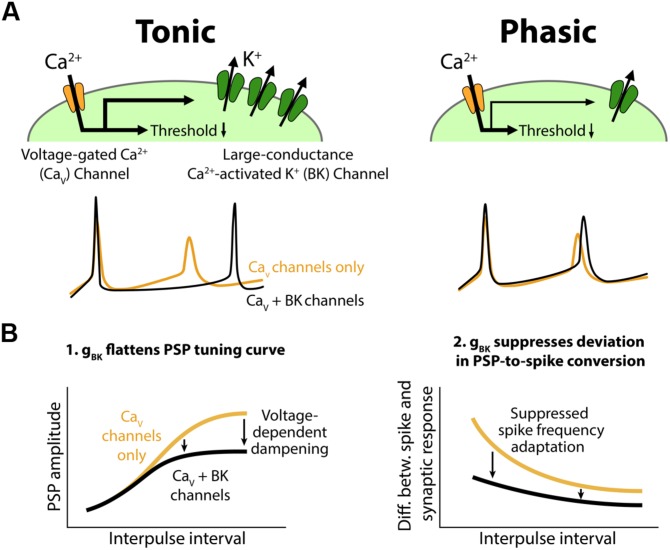FIGURE 10.
Conceptual model for the role of BK channels in shaping interval tuning. (A) Top, Both tonic (left) and phasic (right) ELp neurons express Cav channels and BK channels. BK current density is larger in tonic neurons. Synaptic depolarization activates the Cav channels below spike threshold, resulting in a reduction in the synaptic current required to induce action potentials. Bottom, ELp neurons show strong spike frequency adaptation without BK currents (yellow; Cav channels only). Fast BK current activated by the Ca2+ influx during action potentials accelerates the membrane repolarization and limits sodium channel inactivation to promote repetitive spiking (black; Cav + BK channels), particularly in tonic neurons (left). Due to the small BK current, phasic neurons still show significant spike frequency adaptation (right). (B) Models explaining how BK conductance (gBK) regulates IPI tuning curves for PSP amplitude (left) and spike number (right). Left, Voltage-dependent Ca2+ influx during synaptic depolarization activates subthreshold gBK in a depolarization-dependent manner. Thus, the larger the synaptic excitation is, the more the resulting PSP is attenuated by the gBK (arrows) so that the overall shape of the tuning curve is flattened. Right, BK current allows neurons to follow stimulus trains with spikes by suppressing spike frequency adaptation. Thus, BK current suppresses the difference between IPI tuning curves that occurs when synaptic input is converted into spike output. This effect is larger at short IPIs compared to long IPIs (arrows) because synaptic responses summate at short IPIs, resulting in large and prolonged excitatory PSPs.

